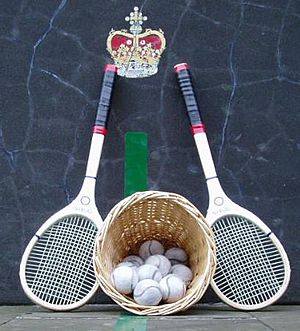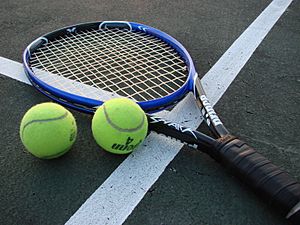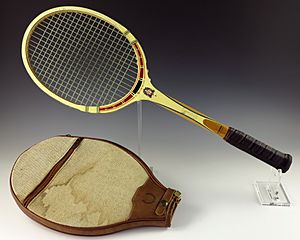Racket (sports equipment) facts for kids
A racket (sometimes spelled racquet) is a special tool used in sports to hit a ball or a shuttlecock. You'll see rackets in games like squash, tennis, racquetball, badminton, and padel.
Most rackets have a handle and a frame with strings stretched tightly across it. Some rackets, like those used in table tennis, have a solid surface instead of strings. These might be called a paddle or bat. All these games together are known as racket sports.
Over time, rackets have changed a lot. Long ago, racket frames were made of wood. The strings were often made from animal gut, called "catgut." (Don't worry, it was never made from cats!) Wooden rackets were limited in size because they needed to be strong enough.
Today, most rackets are made from strong, light materials. These include carbon fiber, fiberglass, or metals like titanium. Synthetic materials like nylon have mostly replaced catgut for strings. Professional players often restring their rackets after every game!
Contents
What's the Right Spelling?
The word can be spelled racket or racquet. In America, racket is the usual way to spell it. In Britain, you might see racquet more often.
Some sports, like tennis and squash, often use the spelling racquet. But the International Tennis Federation uses racket. The word racket is actually older, from the 1500s. Racquet appeared later, influenced by French spelling.
Where Did the Word Come From?
The exact origin of the word "racket" isn't fully clear. It might come from a Flemish word "raketsen." This word itself might come from an old French word "rachasser," which means "to hit the ball back."
Badminton Rackets
Badminton rackets are very light. The best ones weigh only about 70 to 95 grams. Modern badminton rackets are made from carbon fiber composite. This material is strong and light, and it helps transfer energy well when you hit the shuttlecock. Older rackets were made of wood, but they were too heavy and expensive.
Badminton rackets come in many designs, but their size and shape must follow the game's rules. Some rackets have a traditional oval head. Others have a more common "isometric" head shape. Companies like Yonex and Victor are very popular for badminton rackets.
Rackets (The Sport)
The sport of rackets is an older game. It's a bit like squash. It uses wooden rackets that are about 30.5 inches (77.5 cm) long. While squash equipment has changed a lot, rackets equipment has stayed mostly the same.
Racquetball Rackets
In racquetball, there are no limits on how much a racket can weigh.
Here are some rules for racquetball rackets:
- The racket can't be longer than 22 inches (56 cm). This includes the handle and any bumper guards.
- The racket frame can be made of any safe material.
- Players must wear a cord attached from the racket to their wrist. This stops the racket from flying away.
- The strings can be made of different materials like gut, nylon, or graphite. They must not mark the ball.
- Using a racket that doesn't follow these rules means you lose the game.
Racquetball rackets usually don't have a long neck. The grip connects directly to the head. Their heads are often wider at the top, sometimes looking like a triangle or teardrop.
Real Tennis Rackets
Real tennis is an older form of tennis. Its rackets are 27 inches (686 mm) long and made of wood. They have very tight strings to handle the game's heavy balls. The racket heads are slightly bent. This helps players hit balls close to the floor or in corners.
Squash Rackets
Squash rackets must follow the game's rules. They used to be made of wood with natural gut strings. Now, they are almost always made of composite materials. These include carbon fiber or metals like graphite, Kevlar, or titanium. They use synthetic strings.
Modern squash rackets are about 70 cm (27.5 inches) long. The strung area can be up to 500 square centimeters (about 75 square inches). They usually weigh between 90 and 200 grams (4 to 7 ounces).
Table Tennis Paddles
Table tennis uses a special table tennis racket. It's made from layers of wood covered with rubber on one or both sides. Unlike other rackets, it doesn't have strings. It's often called a "paddle" in the USA, a "bat" in Europe, and officially a "racket" by the ITTF.
Here are some key rules for table tennis rackets:
- The racket can be any size, shape, or weight, but the hitting part must be flat and stiff.
- At least 85% of the hitting part must be natural wood.
- The rubber covering on the hitting side can be "pimpled rubber" (bumpy) or "sandwich rubber" (bumpy rubber over a sponge layer).
- The covering must go up to the edge of the wood, but not beyond it.
- The surface of the rubber must be dull (not shiny). One side must be bright red, and the other black.
- Players must show their racket to their opponent and the umpire before a match.
Tennis Rackets
Modern tennis rackets come in different lengths, weights, and head sizes. Almost all adult rackets today are made from a graphite composite. Older rackets made of wood, steel, or aluminum are rarely used now.
- Length: Junior rackets are usually 21 to 26 inches (53 to 66 cm) long. Adult rackets are typically 27 inches (68.5 cm). Some are a bit longer, up to 29 inches (73.5 cm).
- Weight: Rackets can weigh from about 7 ounces (198 grams) unstrung to 12.6 ounces (357 grams) strung. Professional players often add weight to their rackets for more stability. Lighter rackets are easier to swing but can twist more when hitting the ball. Heavier rackets offer more power and stability but are harder to move quickly.
- Head Size: This is very important for how a racket performs. A larger head size generally means more power and a bigger "sweet spot." The sweet spot is the best part of the strings to hit the ball. A smaller head size usually gives more control, especially for hitting balls close to the lines.
Today, most professional tennis players use rackets with head sizes between 95 and 115 square inches (613 to 742 sq cm). Rackets with smaller or much larger heads are still made but are not common among pros.
Stringing and Dampeners
The strings in a tennis racket are very important. They can be made of different materials, like natural gut or polyester. The tightness of the strings, called "tension," also affects how the racket plays.
- Lower tension usually gives more power.
- Higher tension usually gives more control.
Many professionals today use stiff polyester strings. This helps them control the ball better, especially with powerful shots.
Some players use small rubber pieces called "vibration dampeners" (or "gummies"). These are placed in the strings near the bottom of the racket. They help reduce the sound and feeling of vibration when hitting the ball. However, they don't really reduce the impact shock that can cause injuries.
History of Tennis Rackets
For most of tennis history, rackets were made of wood. Their heads were usually around 65 square inches (419 sq cm). In the late 1960s, Wilson made a popular steel racket called the T-2000. It was used by famous players like Jimmy Connors.
In the 1970s, aluminum rackets became popular. Then, in the early 1980s, "graphite" (carbon fibre) rackets were introduced. These were much lighter and stiffer than wood or metal rackets. They quickly became the standard for professional tennis. The last wooden racket used at Wimbledon was in 1987.
Modern graphite rackets are much stiffer than older ones. This gives players more power and control. However, some people believe this stiffness has also led to more injuries like tennis elbow.
See also
 In Spanish: Raqueta para niños
In Spanish: Raqueta para niños








